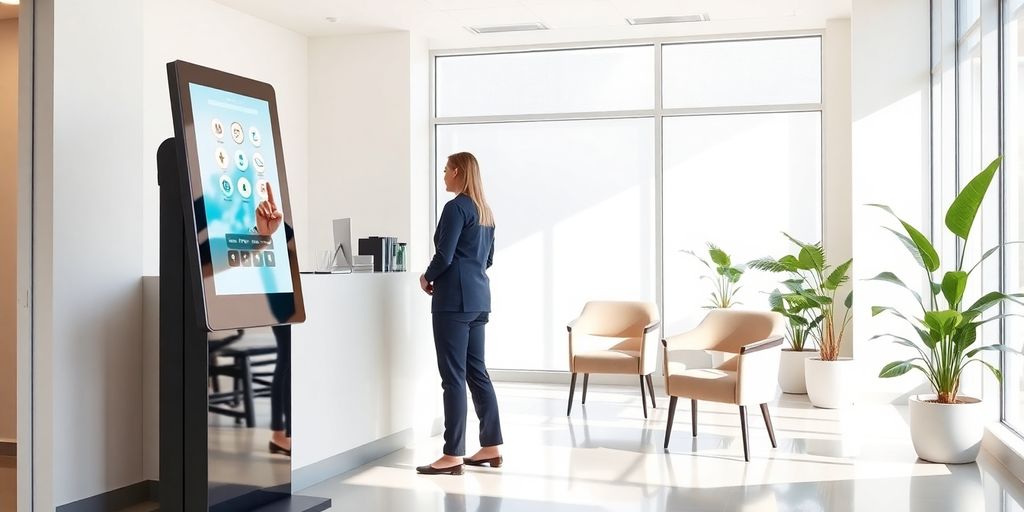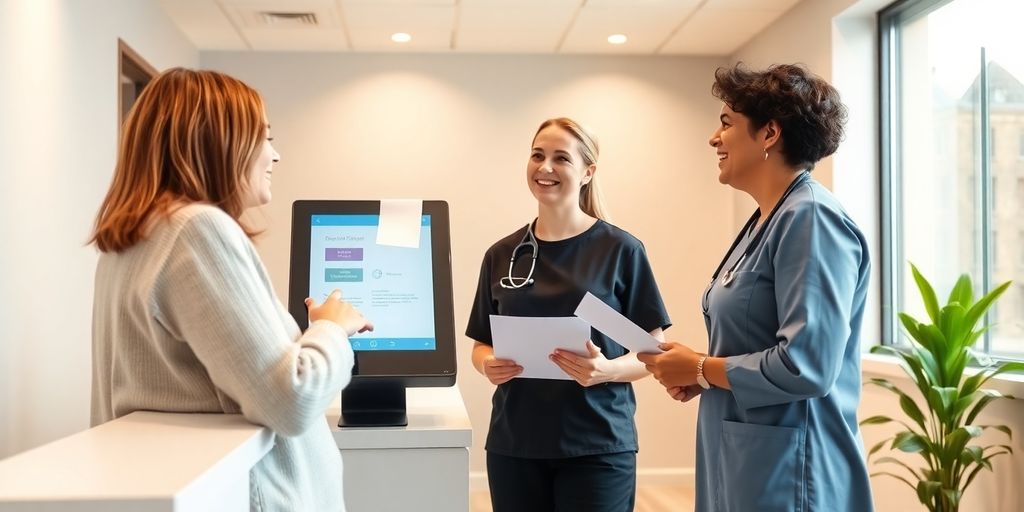Ever sat in a clinic waiting room, noticing the reception desk buried in forms? An automated patient check-in system can flip that script. It hands back time to your staff and cuts lines in half. This article walks you through simple steps to speed things up, keep your data spot on, and track your bottom line.

An automated patient check-in system isn't just about being modern; it's about moving more patients through your clinic, faster. Think of it as optimizing the patient flow appointment scheduling to reduce bottlenecks and wasted time.
Traditional waiting rooms are inefficient. Patients bunch up, staff gets overwhelmed, and everyone's stressed. An automated system smooths this out. It allows for pre-arrival check-in, reducing the number of patients physically waiting. This means less congestion and a calmer environment.
Every clinic has peak hours. An automated system can help manage these surges. By allowing patients to check in remotely or at kiosks, you distribute the workload. This prevents the front desk from becoming a chokepoint. Consider using My AI Front Desk to handle calls during peak hours.
No-shows are a drain on resources. An automated system can track these and identify patterns. This data can then be used to implement strategies to reduce no-shows, such as automated reminders or adjusted scheduling policies. This helps to improve patient satisfaction.
An automated system isn't a magic bullet, but it's a powerful tool. It allows you to see where the bottlenecks are and make informed decisions about how to improve patient flow. It's about using technology to make your clinic run more efficiently, so you can focus on what matters most: patient care.

Giving patients more control over their healthcare journey is a big win. It cuts down on staff workload and makes the whole experience smoother. Think about it: fewer phone calls, less paperwork, and happier patients. It's about shifting from a reactive model to a proactive one, where patients can handle many tasks themselves.
Mobile check-in is a game-changer. Patients can complete forms, update insurance info, and even pay co-pays from their phones before they even arrive. This slashes waiting room times and lets staff focus on more important tasks. It's simple: send a link via text or email a day or two before the appointment. Patients click, complete the necessary steps, and they're good to go. It's all about convenience and efficiency. This also helps with patient education.
Kiosks are another way to give patients self-service options. They can check in, update their info, and even schedule follow-up appointments without interacting with staff. Touchless kiosks, using QR codes or voice activation, are even better, especially now. They reduce the risk of spreading germs and make patients feel safer. Plus, they free up staff to handle more complex tasks.
Patient portals are secure online platforms where patients can access their medical records, view test results, request prescription refills, and communicate with their healthcare providers. These portals are essential for fostering patient engagement and improving communication. They give patients 24/7 access to their health information, which can lead to better health outcomes. A good portal should be easy to use, secure, and integrated with the practice's AI phone receptionist and other systems.
Self-service options aren't just about convenience; they're about empowering patients to take control of their health. By giving them the tools and information they need, we can create a more engaged and proactive patient population.
It's not enough to just automate check-in; it has to play nice with what you already use. Think of it as adding a new wing to your house – it needs to connect to the existing structure, not just sit awkwardly beside it. The goal is to make data flow smoothly, not create more silos.
Data entry is a time sink. The point of automation is to kill it. Real-time sync means patient info, insurance details, and appointment times update across systems instantly. No more double entry, no more transcription errors. It's about smooth clinic flow.
Missed appointments kill efficiency. Automated updates mean the check-in system talks to your scheduling software. When a patient checks in (or doesn't), the schedule reflects it immediately. This lets staff react faster, filling slots and reducing downtime. It's about AI phone receptionist.
Not everyone needs to see everything. Role-based access means you control who sees what data. Front desk staff might need access to check-in status, but not billing info. Doctors need full patient records, but not necessarily HR data. This protects patient privacy and keeps things organized.
Think of integration as an investment, not an expense. A well-integrated check-in system pays for itself in reduced errors, saved time, and happier staff. If it doesn't, you're doing it wrong.
Automated patient check-in systems do more than just speed things up. They also play a big role in making sure your data is correct and that you're following all the rules. It's not just about being faster; it's about being better.
Forget manually checking insurance details. These systems can automatically verify a patient's insurance coverage before their appointment. This cuts down on billing errors and claim denials. It also means less work for your staff, who can focus on other things. This automation is a game-changer for revenue cycle management.
Getting patient information right from the start is key. Automated systems can validate demographic data in real-time, flagging any inconsistencies or missing information. This ensures that your records are accurate and up-to-date. Think of it as a first line of defense against errors. You can even use dental management software to help with this.
Audits can be a headache, but they don't have to be. These systems generate detailed reports that are ready for audits. You'll have all the information you need at your fingertips, making the process much smoother. No more scrambling to find documents or reconcile data.
Having accurate data isn't just about avoiding penalties. It's about providing better care. When you have a clear and complete picture of each patient, you can make more informed decisions and deliver more effective treatment.
It's easy to get caught up in the excitement of new tech, but you need to know if it's actually working. An automated patient check-in system is no different. How do you measure its impact and, more importantly, its return on investment (ROI)? Let's break it down.
Before you implement anything, get a baseline. Time how long it takes patients to check in manually. Track the number of patients seen per hour. Note the staff time spent on check-in tasks. This is your "before" picture. After implementation, compare these metrics. Are check-in times shorter? Are you seeing more patients? Is staff spending less time on check-in tasks? If not, something's wrong.
Quantify the savings. This isn't just about feeling more efficient; it's about real dollars. Consider:
Don't forget to factor in the cost of the system itself. Include the initial investment, ongoing maintenance, and any training expenses. Calculate the payback period – how long it takes for the savings to offset the costs.
Efficiency isn't everything; patient experience matters. Use surveys or feedback forms to gauge patient satisfaction with the new system. Ask about ease of use, convenience, and overall experience. A happy patient is more likely to return and recommend your clinic. Here's a simple example:
If satisfaction scores are low, investigate why. Is the system confusing? Are patients having trouble with the technology? Make adjustments as needed. Remember, the goal is to improve both efficiency and the patient experience. Consider using AI Frontdesk to improve patient experience.
It's easy to overlook user experience and accessibility when focusing on the technical aspects of an automated check-in system. But a poorly designed system will frustrate patients and staff, negating any efficiency gains. The goal is to create a system that is intuitive and usable for everyone, regardless of their technical skills or physical abilities.
Simplicity is key. Overloading the interface with too much information or complex navigation will lead to confusion. Here are some guidelines:
Accessibility isn't just a nice-to-have; it's a legal requirement. The Americans with Disabilities Act (ADA) mandates that systems be accessible to people with disabilities. HIPAA requires that patient data is protected. This means:
Failing to comply with ADA and HIPAA can result in fines and legal action. More importantly, it excludes patients and undermines trust.
In many areas, a significant portion of the population speaks a language other than English. Providing multilingual support is essential for ensuring that all patients can use the system effectively. This involves:

AI is moving beyond simple automation. Imagine an AI that analyzes patient symptoms during check-in, routing them to the appropriate specialist or care pathway. This isn't just about efficiency; it's about improving patient outcomes by ensuring they receive the right care, faster. This could be a game changer for patient intake process.
Typing on a screen, even a touchscreen, can be a barrier for some patients. Voice activation offers a more natural, accessible alternative. Think of it: patients simply speaking their name, date of birth, and reason for visit. Nuance is key here. The system needs to understand different accents and speech patterns. It's not just about convenience; it's about inclusivity.
No-shows are a huge drain on clinic resources. Predictive analytics can help. By analyzing historical data – appointment history, demographics, even weather patterns – the system can identify patients at high risk of not showing up.
This allows for proactive interventions, like targeted reminders or rescheduling options, minimizing wasted appointment slots and improving resource allocation. It's about using data to make smarter decisions.
Here's a simple example of how predictive analytics might categorize patients:
This is where My AI Front Desk can really shine, by automating those reminders and follow-ups. It's about making the system work for you, not the other way around.
Patient check-ins will soon run smoother. These newer kiosks can remind you of your appointment and even send quick texts. Head over to our website today to learn more.
After wrestling with paper forms and long lines, an automated check-in feels like swapping a flip phone for a smartphone. Wait times drop, your front desk isn’t buried under stacks of files, and patients actually breeze through the door. It won’t solve every problem, but it lifts a huge burden off your team and cuts down on mistakes. You don’t need a tech degree to get it up and running—just a clear plan and a bit of trial and error. Give it a shot, watch your clinic hum, and enjoy a day that feels a whole lot lighter.
It’s a computer-based tool that lets patients sign in on their own. They use a kiosk, phone app, or portal so staff don’t have to do it by hand.
By cutting down paperwork and line-ups. Patients enter their info themselves, so your team can help more people in less time.
Yes. Many systems have a phone or web option. Patients fill out forms at home, so they just confirm details when they get to the clinic.
Most systems link right into your practice software. They share appointment updates, patient info, and billing data in real time.
Absolutely. It checks insurance, double-checks names and dates, and keeps a record you can report on. That helps you stay legal and avoid mistakes.
You can measure faster check-ins, lower no-show rates, and happier patients. Over time, the money you save and the extra bookings often cover the system cost.
Start your free trial for My AI Front Desk today, it takes minutes to setup!








